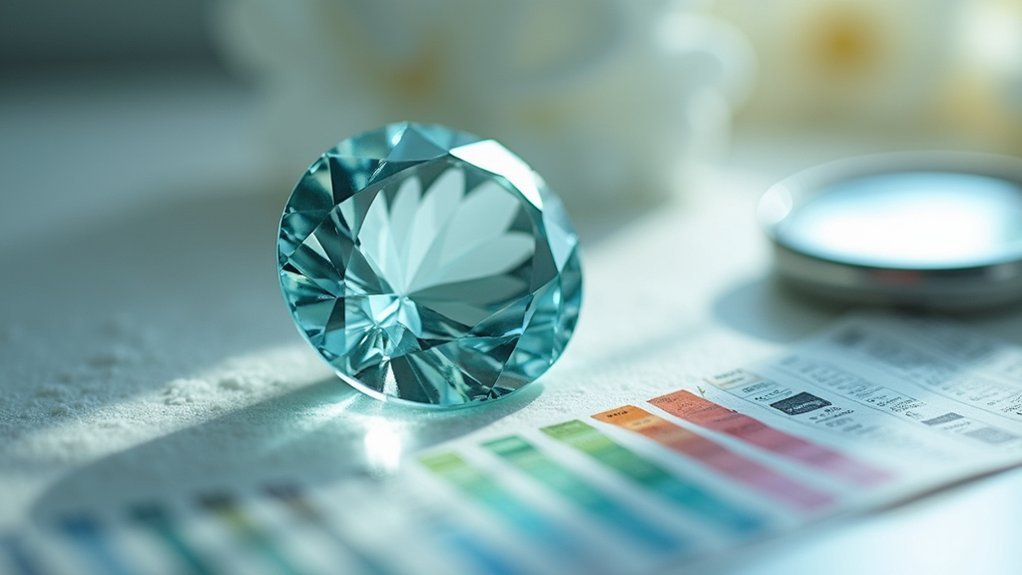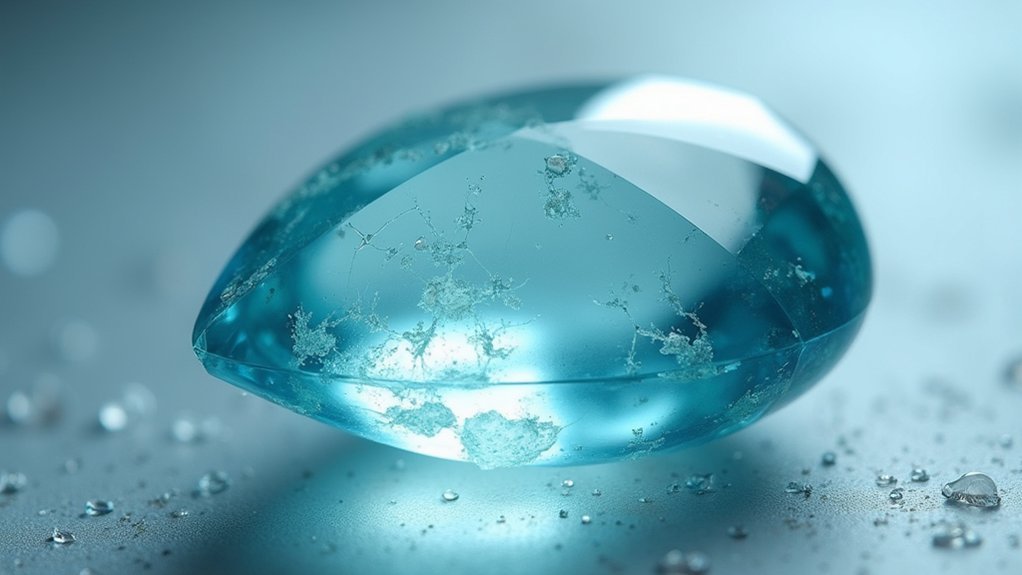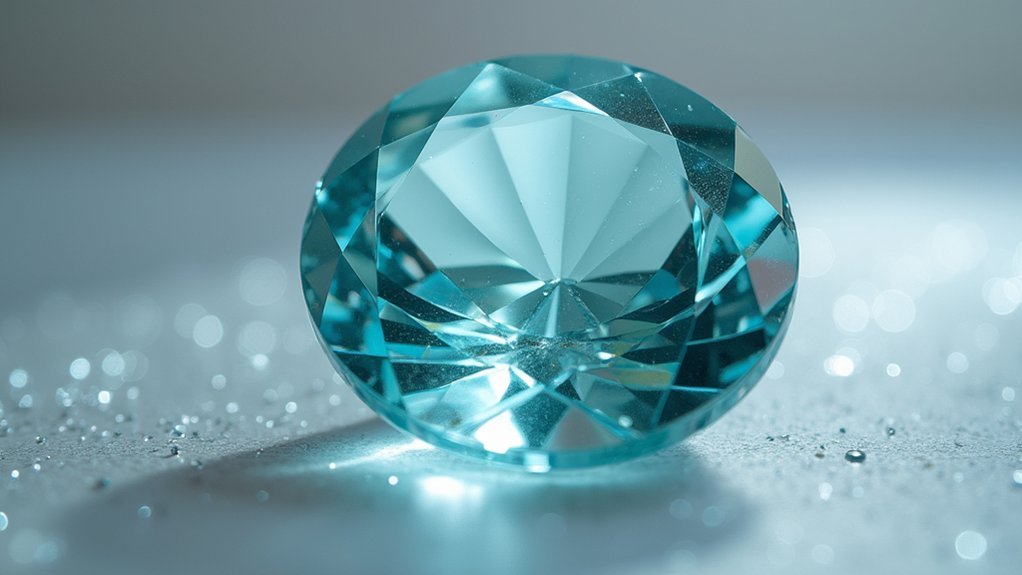Aquamarine, a Type I gemstone, follows a four-tier clarity grading system: GEM (AAAA), AAA, AA, and B. You’ll want to use a 10x loupe for initial assessment and look for tube formations, feathers, and crystal inclusions. Eye-clean stones (AAAA and AAA) command premium prices, while visible inclusions considerably reduce value. Natural daylight provides the most accurate environment for grading. Proper cutting enhances both clarity and color perception in your final jewelry pieces.
Understanding Type I Gemstone Classification

When evaluating aquamarine quality, you’ll find its Type I classification plays an essential role in setting clarity expectations. This designation means aquamarines naturally occur with minimal inclusions, making them mainly eye-clean even in their rough state.
In aquamarine grading, this Type I status offers a distinct advantage—you’ll encounter stones with excellent transparency and visual clarity more frequently than with other gemstone varieties.
While hollow tubes and needle-like inclusions can appear, they’re typically minor and don’t greatly impact the stone’s overall clarity grade.
Remember that while color remains the primary value factor in aquamarine assessment, clarity still influences market value.
You’ll find that the abundance of inclusion-free aquamarines makes them particularly desirable for fine jewelry applications where pristine appearance is paramount.
The Professional Aquamarine Clarity Scale
Unlike many colored gemstones, aquamarine follows a specialized clarity grading system that reflects its exceptional transparency.
When evaluating quality aquamarine, you’ll encounter a four-tier classification: GEM (AAAA), AAA, AA, and B grades.
GEM-grade stones represent the pinnacle of clarity grading, being completely free of visible inclusions even under magnification.
AAA specimens are eye-clean but may reveal minor inclusions under a loupe.
AA stones might contain visible inclusions upon close inspection, while B-grade aquamarines have obvious inclusions visible to the naked eye.
As a Type I gemstone, aquamarine naturally forms with fewer inclusions than many other colored stones.
While clarity isn’t as critical as with diamonds, it greatly impacts both aesthetic appeal and market value of fine aquamarine specimens.
Common Inclusions in Aquamarine

When examining aquamarine clarity, you’ll notice tube formations as the most common inclusions, appearing as long, hollow channels within the crystal structure.
These distinctive tubes differ considerably from feather inclusions, which resemble small cracks or fissures radiating from a central point.
Crystal inclusions, meanwhile, present as dark, solid mineral formations (often chromites) embedded within the aquamarine’s body, creating a different visual impact than the more linear tube structures.
Identifying Tube Formations
How can you recognize the most distinctive feature affecting aquamarine clarity? Look for long, hollow structures that appear as thin lines or channels running through the stone. These tube formations are the most prevalent inclusions in aquamarine, resulting from the natural crystallization process of beryl.
When grading aquamarine clarity, you’ll need to assess these tubular inclusions carefully. Note their size, visibility, and orientation within the gemstone.
While their presence is typical, tubes shouldn’t automatically lower your evaluation. Only prominent, highly visible tubes greatly impact clarity grades.
High-quality aquamarines contain minimal visible tube formations, but even stones with some tubes can remain valuable if the inclusions don’t detract from the gem’s overall beauty.
Consider how tubes affect light performance and the stone’s aesthetic appeal when making your assessment.
Feathers vs. Crystals
While tube formations represent the most common clarity feature in aquamarines, two other inclusion types merit careful examination: feathers and crystals.
Feathers appear as thin, hair-like inclusions that create white or translucent lines within the stone, while crystals are solid mineral inclusions that vary in size and composition.
When evaluating these inclusions for clarity grading, examine them under magnification to assess their impact:
- Visibility – Feathers are typically less distracting than larger crystal inclusions, which can be noticed without magnification.
- Distribution – Note how inclusions affect the stone’s brightness and overall aesthetic.
- Severity – Higher clarity grades (AAAA/AAA) require minimal to no visible inclusions.
Understanding the distinction between feathers and crystals will greatly improve your accuracy in aquamarine assessment.
Evaluating Eye-Clean vs. Included Specimens
Although all gemstones contain some microscopic inclusions, the distinction between eye-clean and included aquamarines forms the foundation of clarity grading.
When evaluating an aquamarine, you’ll need to determine whether inclusions are visible without magnification.
GEM and AAA-grade aquamarines must appear completely clean to the naked eye, maximizing brilliance and commanding premium prices.
These stones exemplify Type 1 characteristics with exceptional clarity.
Type 1 gemstones with flawless clarity represent aquamarine at its finest—pure, brilliant, and worthy of connoisseur appreciation.
In contrast, AA-grade specimens display noticeable inclusions visible without magnification, considerably reducing their market value.
Watch specifically for hollow tubes, needles, and lily pad formations, as these common inclusions most frequently impact aquamarine clarity.
Remember that even small visible inclusions can dramatically affect a stone’s overall appeal and price point, making clarity assessment a critical skill for jewelers evaluating aquamarine quality.
Clarity Enhancement Techniques and Detection

Understanding aquamarine clarity enhancements becomes paramount after identifying natural inclusions in your specimens.
When grading aquamarine, you’ll encounter stones that have undergone treatments to improve their appearance. Common techniques include fracture filling and laser drilling, which can greatly alter a gem’s market value.
To properly detect these enhancements, you’ll need:
- Microscopic examination skills to identify the telltale signs of filled fractures or drilled channels
- Spectroscopy knowledge to detect chemical agents used in enhancement processes
- Regular gemological training to stay current with evolving enhancement methods
As a professional jeweler, your ability to recognize clarity enhancements guarantees transparent communication with customers.
Remember that AAAA and AAA grades are typically eye-clean naturally, while enhanced AA specimens require proper disclosure to maintain trust and ethical standards.
Clarity’s Impact on Aquamarine Value
As a Type I gemstone, aquamarine’s value dramatically increases when it achieves the eye-clean premium standard that collectors and jewelers seek.
You’ll notice price jumps of several hundred dollars per carat when comparing stones with visible inclusions to those that appear flawless to the naked eye.
While color remains the primary value factor, clarity markedly impacts your investment potential, with GEM and AAA grades commanding substantially higher prices than their inclusion-riddled AA counterparts.
Inclusions Affect Pricing
While beauty often lies in the eye of the beholder, aquamarine pricing follows more concrete rules when it comes to clarity. When you’re evaluating valuable aquamarine specimens, you’ll notice that inclusion levels directly impact their market value. GEM and AAA grades command premium prices precisely because they’re eye-clean or loupe-clean without visible flaws.
Inclusions affect your investment in three significant ways:
- Price differential – Eye-clean stones can cost hundreds more per carat than included stones.
- Jewelry suitability – Clearer stones are preferred for fine jewelry, increasing their demand.
- Grade determination – AA-grade stones with visible inclusions will always be priced lower than their cleaner counterparts.
Remember that most aquamarines are naturally eye-clean, making heavily included specimens less desirable in the marketplace.
Eye-Clean Premium Standard
The eye-clean standard stands as the primary benchmark determining aquamarine’s market value in today’s gemstone industry. When you’re evaluating aquamarines, remember that stones without visible inclusions to the naked eye command considerably higher prices, especially in GEM and AAA grades.
| Clarity Grade | Characteristics | Visual Appeal | Inclusion Visibility | Price Premium |
|---|---|---|---|---|
| GEM Grade | Exceptional clarity | Superior brilliance | None visible to eye | Highest |
| AAA Grade | Very high clarity | Excellent luster | None visible to eye | High |
| AA Grade | Good clarity | Good appearance | May have visible inclusions | Moderate |
| A Grade | Fair clarity | Acceptable | Visible inclusions | Low |
| B Grade | Poor clarity | Compromised | Numerous inclusions | Minimal |
While lower grades may still possess the beautiful blue color aquamarines are known for, their value drops considerably when inclusions become visible without magnification.
Type I Gemstone Classification
Gemological classifications place aquamarine firmly in the Type I category, representing stones that naturally form with minimal inclusions. This designation sets high expectations for aquamarine gemstones in the marketplace, as buyers anticipate exceptional clarity as a standard feature rather than a luxury.
When conducting clarity grading of aquamarine, remember these key value factors:
- Premium Pricing – Eye-clean specimens command considerably higher market values, often increasing exponentially with improved clarity.
- Rejection Rate – Stones with visible inclusions are frequently rejected for fine jewelry, limiting their commercial potential.
- Investment Quality – The clearest specimens retain value better over time, making them superior long-term investments.
The Type I classification fundamentally means you’ll disappoint clients if you offer aquamarines with visible flaws, as the standard expectation is pristine clarity.
Tools for Assessing Aquamarine Clarity
Proper evaluation of aquamarine clarity requires specific instruments and conditions to detect even the most subtle inclusions. When performing clarity grading, you’ll need a jeweler’s loupe or microscope with 10x magnification to examine stones thoroughly and determine if they’re eye-clean.
| Tool | Purpose | Ideal Usage |
|---|---|---|
| 10x Loupe | Basic inclusion detection | Initial screening |
| Microscope | Detailed inclusion analysis | Final grading assessment |
| Natural Daylight | True color representation | Morning examination |
| Specialized Gem Light | Controlled illumination | Indoor assessment |
The right lighting is essential—natural daylight offers the most accurate view of a stone’s clarity. Always consult a standardized clarity chart when categorizing stones from flawless to heavily included. Remember that AAA or GEM grade aquamarines must be eye-clean, while AA grades may show visible inclusions.
Relationship Between Color and Clarity Perception

While many collectors focus solely on the famous “Aquamarine blue” hue, you’ll find that clarity plays an equally essential role in how you perceive a stone’s color.
In top-grade aquamarines (GEM/AAAA and AAA), high clarity allows light to travel unimpeded through the crystal, showcasing the true depth of blue or greenish-blue tones that collectors prize.
When examining aquamarines, you’ll notice:
- Higher clarity directly enhances color vibrancy by allowing maximum light transmission
- Type 1 eye-clean stones display richer, more saturated color than included specimens
- AA-grade stones with visible inclusions often appear washed-out as inclusions scatter light and diminish color intensity
Grading Standards Across Different Markets
When shopping for aquamarine across different markets, you’ll encounter varying clarity grading standards that directly impact stone valuation.
The U.S. market typically follows the AAAA-to-B scale, while international dealers may emphasize different clarity aspects based on regional preferences.
Understanding these market-specific expectations will help you navigate price differences and guarantee you’re making fair comparisons when purchasing aquamarine jewelry.
Global Grading Variances
Unlike diamonds, which benefit from the widely accepted GIA standards, aquamarine lacks a universal grading system, creating significant variations in how quality is assessed worldwide.
When purchasing valuable aquamarine, you’ll encounter different grading terminologies depending on your location—some markets use the GEM (AAAA), AAA, AA, and B classification, while others follow entirely different standards.
This regional diversity affects valuation in three key ways:
- Color preference variance – Some markets value deeper blue stones, while others prefer the lighter “sky blue” hues.
- Clarity importance fluctuation – Certain regions tolerate inclusions that others might consider deal-breakers.
- Cut quality emphasis – The importance of proportions and brilliance varies dramatically between markets.
Always verify what grading system your jeweler uses before making purchasing decisions.
Regional Quality Expectations
Regional markets worldwide have developed distinctly different standards for what constitutes a “high-quality” aquamarine, creating a complex landscape for buyers to navigate.
In the U.S., jewelers should stock AAA and AAAA grades that are eye-clean with rich saturation for fine jewelry applications.
European clients typically expect exceptional clarity, often prioritizing transparency over color intensity in their grading assessments.
Meanwhile, the growing Asian market, particularly China, has evolved to value a balanced approach where clarity considerations accompany color and cut in purchase decisions.
As a jeweler, you’ll need to adjust your inventory based on your clientele’s regional expectations.
While some markets rely on informal grading systems, understanding standardized clarity assessments like those from GIA will help you communicate quality consistently regardless of where your customers’ preferences originated.
Market Price Influences
The scarcity of premium aquamarines dramatically shapes their market value, with only about 10% of available stones meeting GEM to AAA classification standards.
As you evaluate aquamarine stones, remember that inconsistent gemstone grading practices across different markets create significant price variations.
When pricing your inventory, consider these critical factors:
- Color intensity – Deeper blue aquamarines command premium prices, often selling for several hundred dollars per carat compared to paler varieties.
- Grading system discrepancies – Non-standardized scales may not align with GIA evaluations, affecting how you should position your merchandise.
- Clarity differentials – The price gap between AA-grade (visibly included) and AAA/GEM-grade stones is substantial, requiring careful distinction in your pricing strategy.
Documenting Clarity in Gemological Reports
When examining gemological reports for aquamarine, you’ll find that clarity documentation serves as the cornerstone of accurate stone assessment.
Professional reports use standardized terminology like “eye-clean” or “included” to describe the visibility of imperfections without magnification.
The grading scale provides essential reference points, with AAAA indicating eye-clean specimens and AA suggesting some visible inclusions may be present.
You’ll want to check if reports specifically document common aquamarine inclusions such as hollow tubes or needle-like formations.
This clarity documentation isn’t just paperwork—it’s a valuable tool that helps you understand the stone’s true quality and make informed purchasing decisions.
When evaluating aquamarines for your inventory or clients, these detailed clarity assessments offer transparency and confidence in your selection.
Clarity Considerations for Custom Jewelry Design

Moving from understanding gemological reports to practical application, custom jewelry design requires specific clarity considerations for aquamarine stones. When creating bespoke pieces, prioritize aquamarines that are eye-clean or loupe-clean, as these higher clarity grades greatly enhance your design’s aesthetic appeal and value.
For exceptional custom work, focus on:
- Selecting AAA or AAAA graded aquamarines with minimal to no visible inclusions for breathtaking clarity.
- Evaluating and minimizing common inclusions like hollow tubes that can detract from your piece’s beauty.
- Choosing well-cut gems that maximize light entry, enhancing clarity and minimizing the visibility of any inclusions.
Remember that clarity directly impacts perceived value – higher clarity aquamarines command premium prices and create more impressive finished pieces that will delight your clients.
Frequently Asked Questions
How Are Aquamarine Stones Graded?
You’ll grade aquamarines using the 4Cs: Color, Cut, Clarity, and Carat. Clarity is essential, with designations ranging from GEM/AAAA (highest, eye-clean) to AA (visible inclusions). Higher clarity means greater brilliance and value.
How to Tell if Aquamarine Is High Quality?
To identify high-quality aquamarine, look for eye-clean stones with no visible inclusions. You’ll want a vivid blue or slightly greenish-blue color, strong transparency, and AAA or GEM grading. Avoid pieces with hollow tubes or dark spots.
What Is the Clarity of Aquamarine?
Aquamarine’s clarity is typically excellent as a Type 1 gemstone. You’ll find most stones are eye-clean with few inclusions. High-quality specimens should be transparent with minimal hollow tubes or needle-like features.
How Do You Appraise Aquamarine?
You’ll appraise aquamarine by evaluating the 4Cs: color (vibrant blue is premium), clarity (eye-clean preferred), cut (affects brilliance), and carat weight. Consider also the stone’s origin and any treatments applied.
In Summary
When you’re grading aquamarine clarity, remember you’re working with a Type I gemstone that’s naturally clean. Always balance technical standards with market preferences, and don’t forget that different regions value clarity differently. Document inclusions accurately in your reports, and consider how clarity affects your custom jewelry designs. With practice, you’ll confidently grade aquamarines and provide clients with transparent, valuable information.





Leave a Reply